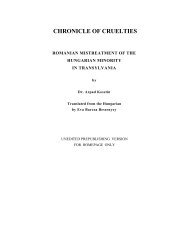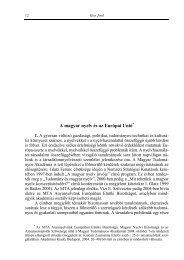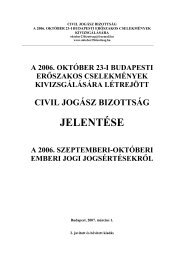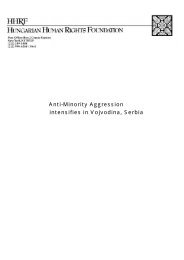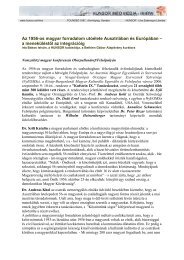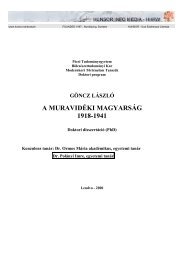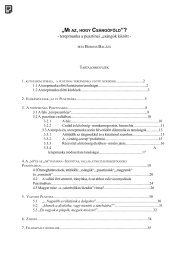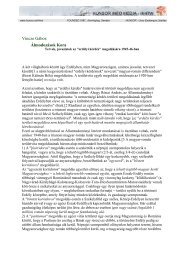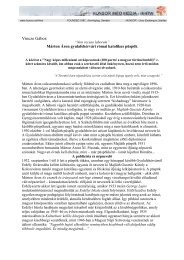PLEASE NOTE: This book contains graphic description ... - HUNSOR
PLEASE NOTE: This book contains graphic description ... - HUNSOR
PLEASE NOTE: This book contains graphic description ... - HUNSOR
Create successful ePaper yourself
Turn your PDF publications into a flip-book with our unique Google optimized e-Paper software.
dig ditches, pits, lug corpses and bury them any old way, it was all the same to them. Finallysome of them were also shot dead."It is characteristic of the work these unlucky men were forced to undertake. Decayedparts of human bodies were dug up by stray dogs near the park as late as 1975.Some of those were not beaten to death in the cellar of the Town Hall, were shot near thepathway leading to the Tisza, others into the river, or on its bank near the dike. They were alsoburied there. There are two mass-graves razed to the ground in this area. Later on relatives putcrosses on the two graves, but these were removed by the authorities. One of the common graveswas next to the path, while the other was near the bank of the Tisza, 150-200 metres to the southbetween the Tisza and the dike. No one has the courage to dig up the graves overgrown withweeds and bushes to rebury the bodies decently.Most of the murderers were Serbians who had lived in Kanizsa before 1941. Besidesthose mentioned above, Alexander Oluski nicknamed Saco and Dusan Ugranov, nicknamedDusko were also involved in the massacre there. The wife of Ugranov was Dragice Kardevanwho was the secretary of the commander of OZNA. They were the ones who asked the youngerprisoners if they wanted to join the Petofi-brigade. When everyone of them accepted this offerjust to save their lives, the Serbian Kanizsa people beat them to death with even greater pleasure.The gesture and the comment made by Dusko as a protest, when he saw the three-hundredthcorpse, were not contrary, "Comrades, let's finish it, if we kill every Hungarian, who will workfor us?" A real humanitarian...It made no difference for those who had been marked for execution, whether they hadbeen fighters in the class struggle or members of any political party whatever, what matteredwas their ethnic origin.In the first few days, a few illusory personal touches characterised the events. Femalerelatives (wives, mothers, sisters) of the prisoners attempted to carry some food to them. It waspassed on to the prisoners by the executioner's assistants and so it wasn't possible to see anyonepersonally. The most "honorable" action of the Serbian partisans was that they gave back thefood which had been brought for men who had been beaten to death. They said that the relativehad been transported somewhere else.The third wave of executions, which demanded only 22 dead, came on November 22nd.It was a Yugoslavian holiday. Dusko and his friends celebrated the holiday with the humorousidea, as they thought of executing 22 Hungarians to fit the date.76Only one man, Antal Dobo (Toni), who had been a member of the party, dared to protestagainst this terrible idea. After he had failed to prevent the "ceremony", he and another strongfellow buried those executed to save their bodies from the pigs of the forester.Saco Oluski, together with the partisans of Adorjan were held responsible for the threehundred victims. He is said to have been condemned to death, but the sentence was never carriedout.We might also mention the case of Dusan Ugranov, he had lived with a guilty consciencesince 1944. He had a nervous breakdown and as a psychiatric patient he would shout, "Help!Save me! The Hungarians will come and execute me!" He had a persecution complex and aclouded mind, he died in 1970.



